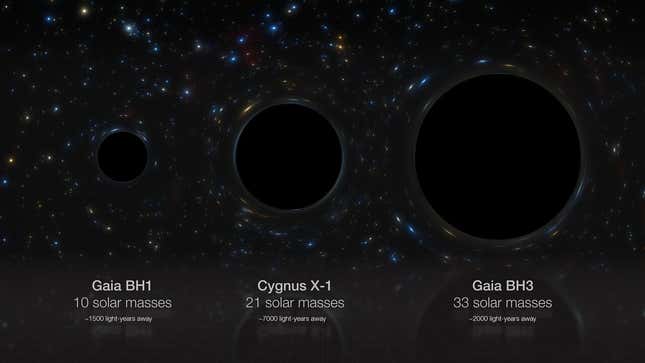The supermassive black gap on the heart of our galaxy is the Milky Manner’s undisputed heavyweight champion, however a newly found object takes the crown for probably the most large stellar black gap recognized in our galaxy, with a mass 33 occasions that of our Solar.
A workforce led by Pasquale Panuzzo, an astronomer on the Paris Observatory, has found probably the most large stellar black gap ever found within the Milky Manner. Gaia BH3 dwarfs the earlier document holder Cygnus X-1, which weighs simply 21 photo voltaic lots. conclusions detailed in a paper revealed as we speak within the journal Astronomy and Astrophysics.

Gaia BH3 is situated within the constellation Aquila, roughly 2,000 light-years from Earth. The workforce found it whereas analyzing information from the European Area Company’s Gaia mission, an area observatory that has been working since 2013. Gaia’s present mission is to construct probably the most detailed 3D map of our galaxy but. The star orbiting BH3 was already recognized to astronomers, however its standing as a black gap companion was a whole shock, and the ensuing weight much more so.
“After I first noticed the outcomes, I used to be satisfied there was an issue with the information. I couldn’t consider it,” Panuzzo advised Gizmodo. “Now I really feel like I’ve actually accomplished That discovery of my life!
The invention was supported by plenty of ground-based observatories and complex devices, together with the ultraviolet and visible echelle spectrograph (UVES) on the European Southern Observatory’s Very Massive Telescope in Chile, the HERMES spectrograph on the Mercator Telescope in Spain, and SOPHIE. high-precision spectrograph in France.
Astronomers used exact measurements of Gaia to find out the dimensions of the orbit and the time it took for the star to orbit the black gap. They then utilized Kepler’s legal guidelines, that are rules that describe the movement of planets and stars, to calculate the black gap’s mass based mostly on the dimensions and interval of its orbit. They used two strategies: astrometric measurements, which observe the mild wiggle of the companion star because it modifications place within the sky, and spectroscopy, which makes use of the Doppler impact to measure the velocity at which the star is shifting in direction of or away from it. us.
Stellar black holes are the stays of large stars which have collapsed underneath their very own gravity, usually forming black holes which are about 10 occasions the mass of our Solar. Gaia BH3’s vital mass suggests it originated from a metal-poor star that retained extra mass throughout its life and thus might have shaped a bigger black gap after its loss of life, based on a brand new examine.
In distinction, the supermassive black gap Sagittarius A*, situated on the galactic core, is way bigger: its mass is about 4 million occasions the mass of the Solar. These giants don’t kind from the collapse of a single star, however possible develop from the merger of smaller black holes and the buildup of gasoline and stellar materials over thousands and thousands of years.
The stellar black gap “shaped from the gravitational collapse of an enormous star—a star possible 40 to 50 occasions extra large than our solar—on the finish of its life,” Panuzzo defined. “Such stars have brief lives, just a few million years, in comparison with the Solar’s 10 billion years, they usually finish their lives in a supernova, abandoning a black gap. That is why we name them ‘stellar’ black holes, in order to not confuse them with the supermassive black holes on the facilities of galaxies.”
Panuzzo mentioned it’s “very possible” that even bigger stellar black holes exist in our galaxy. Beforehand LIGO-Virgo-CAGRA gravitational telescopes found the merger of black holes with a mass of greater than 80 photo voltaic lots in distant galaxies. Certainly, heavy stellar black holes have been found earlier than, however in different galaxies and utilizing different detection strategies. These distant black holes are recognized utilizing gravitational wave astronomy, which observes ripples in spacetime attributable to the merger of stellar black holes. I requested Panuzzo why we have been capable of finding large stellar black holes in galaxies far, distant, however solely just lately noticed one in our personal galaxy.
“There are two causes,” he mentioned. “First, the LIGO-Virgo-KAGRA gravitational telescopes are able to detecting black gap mergers very distant, analyzing billions of galaxies. The second is that these black holes are produced by large stars with low metallicity,” that’s, stars composed virtually solely of hydrogen and helium, with solely traces of different components. “These stars have been solely current in our galaxy of their infancy, so we will now not see the formation of recent large black holes in our galaxy,” says Panuzzo.
The information used within the examine was initially meant for Gaia’s subsequent information launch, anticipated by the tip of 2025. Nonetheless, because of the significance of the invention, the workforce determined to publish the outcomes earlier. “This discovery has necessary implications for fashions of stellar evolution and the gravitational wave discipline,” Panuzzo defined. “It was felt that this extraordinary discovery shouldn’t be saved from the group for 2 years whereas ready for the subsequent launch.” Furthermore, by revealing it now, the scientific group will be capable to make follow-up observations sooner, he added.
To this finish, future observations with the GRAVITY instrument on ESO’s Very Massive Telescope Interferometer will intention to find out whether or not this black gap is attracting matter from its environment, permitting for larger understanding of its nature and conduct.
Extra: Ripples in space-time reveal mysterious object colliding with star’s corpse.
